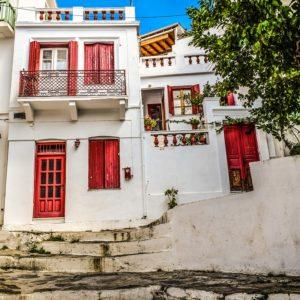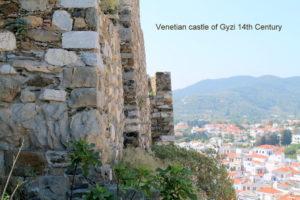The town of Skopelos, also known as Chora, is located on the eastern side of the island.
It is a traditional settlement by Presidential Decree (19/10/78 Presidential Decree 594, 13-11/78), mainly due to its architecture. The mixture of different architectural styles gives the island’s capital a sophisticated aura of another era. According to the latest census, it has 3,090 permanent residents.
Skopelos Town attracts the interest of artists, painters and photographers. Built amphitheatrically on a steep slope, it extends from the Venetian castle to the harbor. Visitors can admire the spectacular sunrise from the Venetian Castle of Chora.
Chora Skopelos is largely inaccessible by car as the buildings lay very close to each other. Walking through its cobblestone alleys is like walking into another era.
The Architecture of Skopelos
Chora has an exquisite architecture, which generally falls into two main styles: folk and neoclassical. Folk architecture is characterized by tall and narrow stone houses with wooden roofs and balconies. After the incorporation of the island into the independent Greek state (1830), neoclassical architecture followed with massive structures and marble balconies, which were usually owned by shipowners and merchants. The island’s buildings testify also its Venetian influences, as well as Pelion and Macedonian architectural traits.
The interiors of the houses feature elaborate furniture and porcelain, brought by the Skopelitian captains and sailors from their journeys.

White walls and red-tiled roofs are the typical colors of Scopelos Chora. Window shutters are usually in shades of brown. But nowadays the owners are painting them in brighter colors like green and blue. Still, in every courtyard and balcony there are small gardens with fruit trees, bougainvilleas and other colorful flowers giving it a fairytale feel.
You will have to climb up the narrow cobblestones to discover the walls of the 13th century Venetian castle and the quiet little squares of Chora with the Aegean Sea in the background. Countless small churches are hidden among the houses, which are highly respected by the locals, preserving their religious tradition.
Wander through the winding cobblestone streets full of flower pots. Observe the beauty of each house separately, the taste of the craftsman, their simplicity and colors. Admire the details of the hanging wooden balconies, the stone roofs, and feel the warmth behind the white curtains. Many expatriates have purchased houses in Chora and take care of them with love and respect.

Around the harbor
Unlike the quiet neighborhoods in the upper parts of Chora, the area around the harbor is bustling with life. Taverns, restaurants, pizzerias, pastry shops, cafes and bars. There are also design shops of quite high aesthetics and quality that offer handmade ceramics, jewelry, clothes and beautiful souvenirs, adding a pretty cosmopolitan tone. Here you will also find 3 Banks, ATMs, Post Office, 2 Pharmacies, Private Medical Practitioners and the Public Health Center.
Recipes like the traditional Skopelitian cheese pie is a must-try. It is a twisted cheese pie, made with local goat cheese.
If you want to get a complete picture of the beauty and uniqueness of Skopelos Town, simply walk uphill from the port to the church of Panagitsa’s Pyrgos (Virgin Mary of the Castle). All along the way, you will enjoy views of the Aegean Sea.

In Chora, the capital of Scopelos, besides the Venetian Castle of Gyzi, you will also find the old Episcopate. It is a Venetian fortified building, built to be the office of the Bishop of Skopelos. However, the Barbarossa’s pirate invasion of the island in 1538, left the building incomplete. In Skopelos Chora, you will also find the Folklore Museum, the Ancient Asklepion (Hospital of the ancient Greeks) and the house of the Greek author Pavlos Nirvanas.

